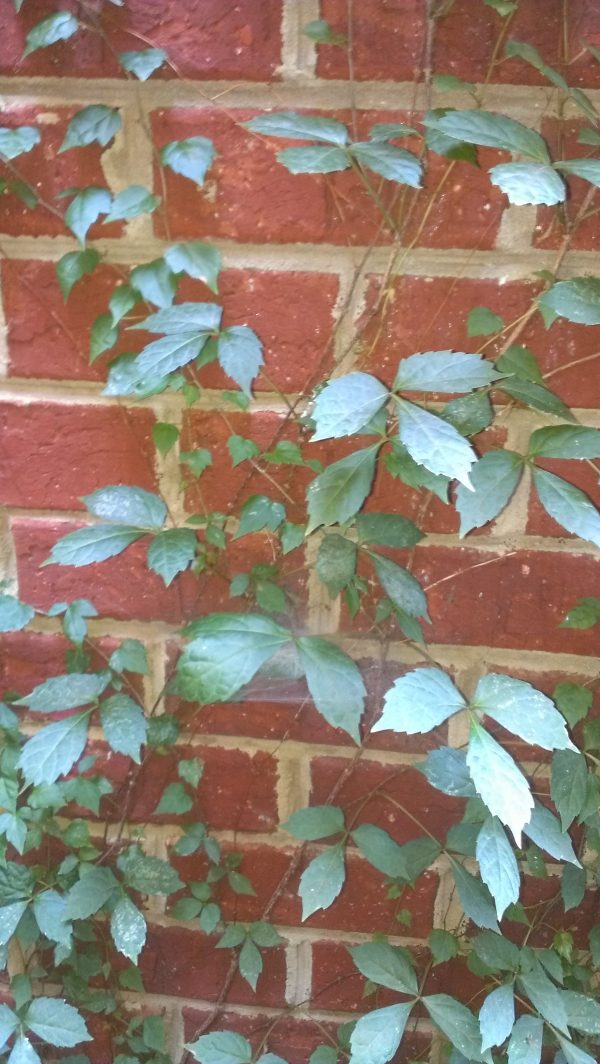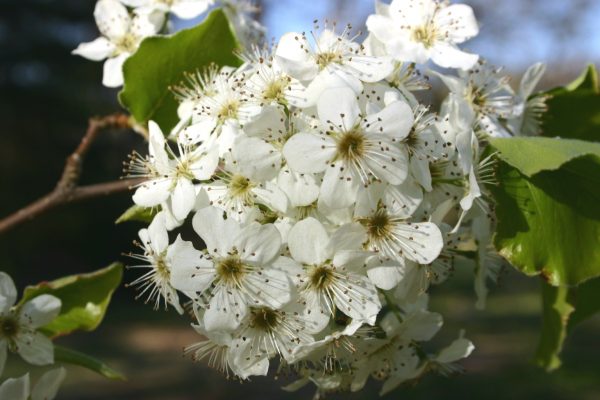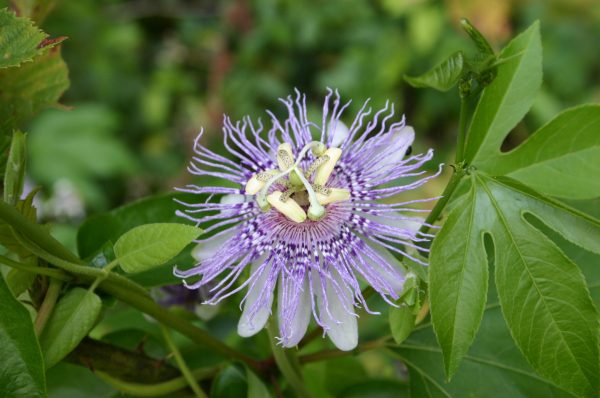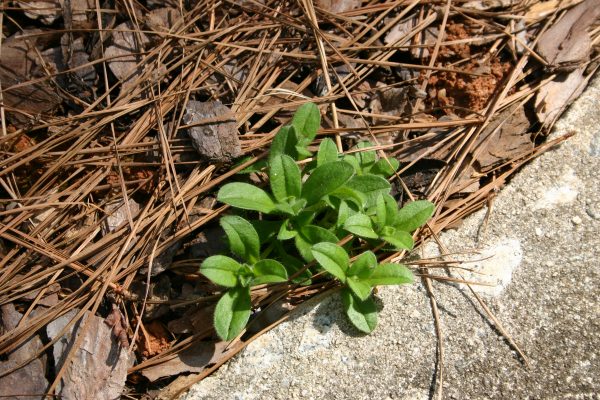Blackberry
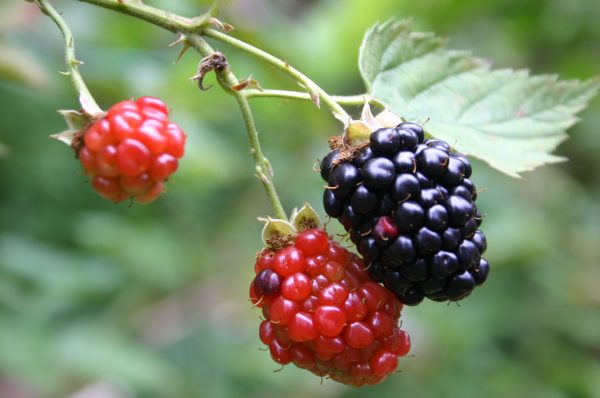
Rubus cv.
Blackberries and raspberries are very similar. They are both brambles that grow on biennial canes emanating from perennial roots. The canes grow vigorously the first year, fruit the second year and then die.
• More detailed information can be found in The Georgia Fruit & Vegetable Book by Walter Reeves and Felder Rushing
• See also Home Garden Blackberries
Good blackberry varieties – Louisiana
The main difference between Blackberries and Raspberries is that raspberries separate from the receptacle and come off as a fragile cup. Another difference is that Blackberries are not as hardy as Raspberries and thornless varieties are less hardy than the thorny varieties.
Blackberries come in two types: upright and trailing. The upright varieties can be planted as a hedge but the trailing types make long vines that need to be supported to keep the berries off the ground and to simplify harvesting. Blackberries are seldom grown for the fresh market, so growing them in the home garden is just about the only way to enjoy them.
WHEN TO PLANT
Plant Blackberries in fall after the first frost or in early spring as soon as the soil can be worked.
WHERE TO PLANT
Choose a site for Blackberries that has well-drained soil and receives full sun (8 to 10 hours per day). Leave enough room so that you can mow around the beds to control the suckers. Blackberries are susceptible to verticillium wilt, a fungus disease that infects the soil and kills susceptible plants growing in it. Do not plant blackberries where susceptible plants such as potatoes, tomatoes or peppers, have been grown in the last 5 years.
HOW TO PLANT
Blackberries are usually sold as 1-year-old, Grade No. 1 plants. Buy only certified disease-free plants from reliable nurseries. Prepare the soil as you would for a vegetable garden. Be sure to kill off perennial weeds such as Bermuda grass or nutgrass using a non-selective herbicide.
Cut off broken roots and soak bare-root plants in a bucket of water to re-hydrate them and to keep them from drying out while you are planting. Plant Blackberries in rows or along a trellis. Blackberries sucker extensively and the erect ones will develop into a thick hedgerow on their own. Space erect Blackberries 2 feet apart in rows 8 to 10 feet apart. Space trailing Blackberry plants ten feet apart in rows 8 to 10 feet apart.
Dig the planting hole at least the diameter of the root spread. Spread out the root system of the bare root or slice roots circling the ball of the container-grown plant before placing it in the planting hole. Set a bare-root or container-grown plant at the same depth it grew in the nursery then carefully cover and firm with soil. Fill the hole with water to firm the soil and force out any air pockets.
CARE AND MAINTENANCE
After planting, cut back the canes to about 1 foot tall. Burn these prunings or dispose of them in the trash to prevent diseases. Mulch well to conserve moisture and reduce weed competition.
Although Blackberries will grow and fruit without support, they are much more attractive and easier to care for when they are trained up in some manner.
Blackberries are very drought-resistant but if you want the best berry size, plan to water as the fruit is ripening. For the first two years, fertilize with 2 pounds of 10-10-10 per 100 feet of row or one-fourth pound per plant in spring and again after harvest. After two years, use 4 pounds and one-half pound, respectively, each time.
TRAILING BLACKBERRIES
In early spring, remove all weak canes and thin the remaining canes. Leave the best 8 to 16 canes per plant. Save only the largest canes. Tie the canes to the wires of your trellis as they grow. As soon as fruiting is completed, remove all canes that bore fruit. Be careful not to injure developing shoots that will bear the next year. Dispose of all trimmings to reduce chances of diseases.
UPRIGHT BLACKBERRIES
In early spring, remove all weak canes and leave 4 or 5 of the most vigorous canes (1/2 inch or more in diameter) per plant. Thin out and cut back laterals (canes that grow horizontally from vertical canes); leave them about 15 inches long with 15 buds each. In summer, pinch back all vertical new canes as they attain the desired height. Pinch unsupported erect Blackberries at 36 inches. Leave canes 6 inches taller if they are supported by a trellis. As soon as fruiting is completed, remove all canes that bore fruit. Be careful not to injure developing shoots that will bear the next year. Dispose of all trimmings to reduce chances of diseases.
Blackberries sucker profusely. Each spring, rototill the perimeter of the planting to eliminate all suckers that have grown outside the row. Hoe out or transplant suckers that develop during the season. Healthy Blackberry plantings should produce for 10 or more years if they are properly maintained. Usually, plantings deteriorate prematurely because of virus diseases. If any plants begin to develop misshapen leaves get rid of them immediately. If the planting begins to produce small berries, consider replacing all plants. There is no cure for virus diseases. Viruses are carried by sucking insects that feed on infected plants or they may be brought in with plants from a non-certified source.
PESTS
Blackberries can be attacked by insects such as Strawberry weevil and the red-necked cane borer. Diseases such as rust, anthracnose and flower blight can disfigure plants or ruin fruit. Your local Extension office can provide you with a spray schedule for specific pests and diseases.
Weed control, especially grass control, is important. Apply mulches to clean plantings, then hoe or pull weeds as they appear.
Fruit – 2020 Homeowner Spray Guide
ADDITIONAL INFORMATION
Harvest the berries as they ripen. Color is the primary indicator of ripeness: reds are red and blacks are black. They deteriorate rapidly, so don’t leave them on the plants. Birds, squirrels and insects will harvest them if you do not.
VARIETIES
Blackberries have varying hardiness. Some varieties tolerate severe cold if they are protected; others are only semi-winter hardy. Thornless varieties are recommended only for plantings in hardiness zone 6b or warmer. Remember, though, old time gardeners swear that “a little blood from the thorns makes a better color in the Blackberry jelly”! Blackberries mature in early to mid- summer around the same time, 60 to 70 days following bloom.
Variety
Comments
Arapaho (erect)
Thornless; ripens 11days before Navaho; medium size fruit
Cherokee (erect)
Thorny; fairly sweet; good producer (especially in Zones 7b and colder)
Cheyenne (erect)
Thorny; slightly tart; very good producer (especially in Zones 8a and warmer)
Kiowa (erect)
Very thorny; very large fruit; fruiting extends for six weeks
Navaho (erect)
Thornless; late ripening for an erect Blackberry; medium size fruit
Gem (trailing)
Thorny; excellent quality; good producer
Black Satin (trailing)
Thornless; good producer.
Hull (training)
Thornless; ripens late June to early July; vigorous



